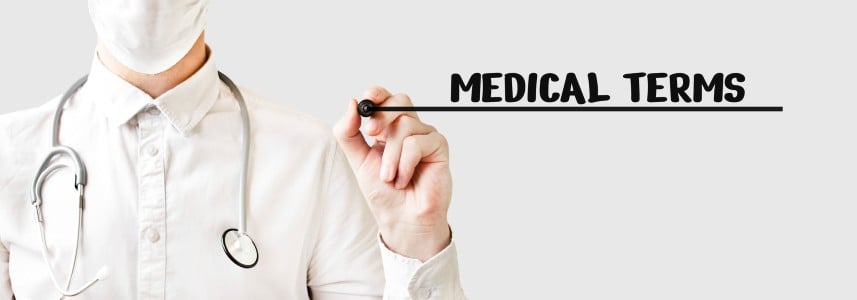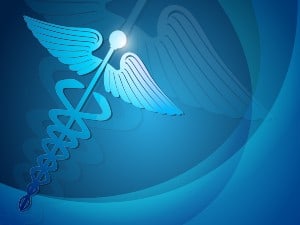Medical Terms & Conditions Defined
Learn about medical definitions, illnesses and diseases.

Learn About Medical Terms, Conditions, Illnesses & Diseases

Learn about thousands of medical terms and conditions - defined and explained. Gain a better understanding of medical terminology at ClusterMed.info.
Have you travelled to a country where nobody spoke the language you understood? How did that feel? You probably would feel overwhelmed, trying to contemplate your next move possibly aloud since nobody understands your language. However, since you don't understand anything around you, an obvious communication barrier is impossible to overcome beyond relying on sign language.
Fields like computer science, medicine and even coding have a lot in common because they all have their own languages. Most medical professionals, if not all of them, need to memorize an entire lexicon of phrases and terms.
The terminology picked up over their years in medical college, but to someone who isn't a doctor, the terms can seem like that of another language or a foreign language. The task of learning these terms for new medical terms may seem unsurmountable, but with time it becomes part of their regular vocabulary.
Medical terminology is used to define, describe and explain the human body components, processes, illnesses, medical procedures, and pharmacology. This can help doctors who run their own small business to avoid having to use their medical practice insurance.
Here we will go through some of the basic medical terms, how they originated, and a few other common examples.
- What Is Medical Terminology?
- What Are The Origins And History Of Medical Terminology?
- What's The Morphology Of Medical Terms?
- What Is The Basic Medical Terms Structure?
- Why Is English Language Used So Much In Medicine?
- How Do You Study Medical Terminology?
- What Are Physician Prescription Abbreviations?
What Is Medical Terminology?

Medical terminology is mainly used to describe various medical processes and components. It is used to describe multiple processes in the human body, different body parts, disorders, medical procedures, pharmacology etc. Put simply, think of it as being the vocabulary that medical professionals use to describe what is happening in the body and their related treatments.
The words used within the system have root words, prefixes, suffixes, and various combo vowels. The elements are combined to create terms that describe multiple conditions.
Take the word "pericarditis," which is used to describe a condition that causes inflation on the outside layer of the heart. The term can be more clearly understood by breaking it down into three parts. The first part is "peri", then "card" and "itis" each part of the term tells us a bit about the condition. "peri" means around, "card" means the heart as in cardio, and "itis" inflation.
To help you find the definitions of medical terms, we offer a free medical dictionary where you can look up the terminology:
0 | 1 | 2 | 3 | 4 | 5 | 6 | 7 | 8 | 9 | A | B | C | D | E | F | G | H | I | J | K | L | M | N | O | P | Q | R | S | T | U | V | W | X | Y | Z
What Are The Origins And History Of Medical Terminology?

Medical terms, many of which we use today, go back several centuries and can be traced back to the ancient Greeks, and in particular, Hippocrates. According to the National Institutes of Health, the earliest records of medical writings are those in the Hippocratic records, that date back to the 4th century BC.
As most readers would imagine, medical terminology has a rich history in Greek and Latin languages. Then when the Romans conquered Greece, the knowledge of both languages and cultures merged, which gave birth to a new set of medical concepts regarding the infection and treatment of various conditions.
Back then, medical records were maintained by hand, with medical terms and books manually drafted by doctors and their assistants. It was also a time when new diseases were being discovered and studied. Take, for instance, etymology, which is the medical term for diabetes, but it has been borrowed from Greek, meaning siphon.
Later it was in the 2nd Century that Aretus the Cappadocian, a famous Greek physician, named the condition diabetes. He also explained that patients with the condition had what's called polyuria, which means they were passing water like a siphon. The term Diabetes, like many others, was derived from Latin or Greek, with suffixes and prefixes forming the end and beginning of various polysyllabic terms.
Over the years, many languages like Dutch, German, Chinese, Spanish, Portuguese and many others contributed to the list of medical terms and continue to contribute to it to this day.
The Latin and Greek used in most medical terms we use today are mainly built on this tradition dating back centuries. Many historians believe that Greek physician Galen and his writings have had a major influence on the medical world for over 15000 years, which is why there are so many ancient Greek words used in medical terms today.
Some other languages that made it to the lexicon were done during the Renaissance; the first anatomists chose to use Latin words (their language) to describe various parts of the human body as they discovered it. Later Arabic made it to the terminology in the Middle Ages since many scholars in the language held roles as medical professors back then.
Then from 1650 to 1850, there was an influx of Latin, which was and still is considered by some the language of the educated, and thus its use was made part of medical instruction and texts. Since much of the medical terms were forged during that period, we encounter a great deal of Latin in medical books today.
What's The Morphology Of Medical Terms?

The morphology mainly describes the various forms that words will take, which depends on the suffixes and prefixes used, in addition to what root word they are adhered to. The good news is that the morphology of medical terms is pretty uniform. The rules that govern combining the words are rooted mostly in Latin.
There are five cases of nouns that can be either plural or singular. The endings mainly dictate the meaning and form of the word, and a single word can take on multiple forms. Take the word "index", for instance, the plural of which we know is "indices." Take the medical term that describes cancerous tissue in the lungs. The phrase used is "adenocarcinoma of the left superior lobe of the lungs", according to Encyclopedia.com.
Now, if you are not a doctor and aren't familiar with medical terminology, you will not be familiar with any of the terms used. However, to understand it, it is essential to examine its components: "Carcin" indicates cancerous tissue. "-oma" which indicates it is an abnormal growth or some type of tumor. "Adeno" is a gland.
If you put all of these together, it means a cancerous growth that is rooted in the glandular cell. The position of cancer, i.e., left, is used to describe the person who has the growth and is being examined, not the person performing the examination. The term "superior" indicates any of the two upper lobes in the left lung.
Almost every student of medicine, even those who aren't studying to become doctors, is quired to memorize a pretty extensive list of prefixes, root words, and suffixes. This helps them fill the road map of the human body as they start becoming more familiar with the terminology.
What Is The Basic Medical Terms Structure?
As alluded to earlier, most medical terms are comprised of three-part words:
- Prefix: The prefix is included at the beginning of the term and will indicate the direction, quantity, location, quality and type of what's to follow.
- Root: The root is what gives the term its meaning. All medical terms have at least one root. So, when the prefix is absent, the term will start with a root.
- Suffix: It is usually located at the end of the term and will indicate test, specialty, status, function, procedure and disorder. It may only define if a word is an adjective, noun or a verb.
A combining vowel: It mainly starts with "o" and is added in between the term to aid in pronunciation.
When words are broken down into parts, they help readers determine their meaning, especially if it's an unfamiliar term. We broke down one example earlier; here is another hypothermia. Here the prefix is "hypo", which means normal. The root of the term is "therm", which means heat, and the suffix "ia" is the condition.
Compound Words
A medical word may also include multiple root words. This often happens when referencing more than one body part or system within the body. Take, for instance, the term cardio-Pulmo-nary, which refers to the lungs and heart. Similarly, gastro-entero-logy refers to the intestines and stomach.
Combining Forms
In medical terms, a combining vowel is often used when a root needs to be followed by another word part that starts with a consonant. This combining vowel is the letter "o", as mentioned earlier too. When added to the root, it can become words like neur-o-logy.
The goal is to aid with pronunciation. The vowel and root, when used together, are referred to as a combining form. To simplify things, the vowel options are removed from the word part tables.
Prefixes
A prefix is used to modify the meaning of the root word used. Usually, the prefix will identify the quality, category and other attributes. However, using the prefix appears optional because it isn't used across all medical terms.
Suffixes
The suffix of a medical term usually includes a procedure, specialty, condition, disorder, or function. Take, for instance, the suffix "ectomy", which refers to removal. A suffix can also be used to turn a noun into an adjective. This means ending with -us, -ae, -um, -e are often used to create a singular noun. An instance of this use is crani-um.
While suffixes appear at the very end of the term, it is often first in the definition. Take, for instance, the medical term appendicitis, which refers to inflammation of the appendix. That's why doctors often read medical terms from right to left, especially if they aren't familiar with them.
There are a few medical terms that are comprised of a suffix and prefix. Take, for instance, the term apnea, which includes the suffix -apnea which means breathing and the prefix a-, which implies absence.
Plural Forms
Adding an "es" or an "s" towards the end of the word is a simple way to turn a word into its plural form in English and many other related Romance languages. However, things can be a little more complex in medical terms. The plural for each medical term is based on the two letters at the end of the singular suffix.
It is worth noting that there are many exceptions. Take, for instance, "virus", which is a Latin term, but it does not have a plural form. However, "viruses" is often accepted as the plural. In other parts of medical terminology, 'es' and 'have prevailed. Take, for instance, "hematoma", the plural form of which is "hematomas" and not "hematomata."
Note: It is worth mentioning that there is a list of forms and prefixes and suffixes available on the internet. These can make studying for and understanding these medical terms a lot easier. We'll go into learning medical terms in the next section.
Why Is English Language Used So Much In Medicine?
Today, much of the medical terminology is derived from English, and it is the language of choice for leading international conferences and journals.
According to the JRSM, doctors choose English as the single international language for communication. In other words, we are not in the era of "medical English."
The latest medical terms aren't rooted in Latin or Greek. Instead, they come from regular English. Words like "bypass operation", "scanning", and "screening" are just a few out of the many latest English medical terms.
In many countries, the English terms have been adopted wholesale, like in the case of "bypass", which is a term accepted in Scandinavian, German, Romanian, Dutch and Italian. It is a term that is also accepted in many non-English speaking countries, which were previously under British rule.
In the section below, we'll break down some specific English medical terms. The objective is to demonstrate how English has become part of medical documentation and literature.
Attending Physician
It is a term that dates back to the earliest days of medicine in North America and has since then become a part of the medical nomenclature simply because it is a term that makes sense. However, nobody can find a definitive source of the term, so we can't tell you when it originated or who was the first person to use it.
Though we can deduce from circumstantial evidence that it may have been a physician that first started using the term.
The term itself was used to describe a physician associated with a particular medical school or institution. This is a lot like students attending a particular school or a physician attending to patients at a hospital. However, the term showed up in 1746 in English literature.
Some people on the internet believe that in the past a, physician would make their rounds on occasion, even though the institution would be run by chief residents. The senior's rounds or attending rounds were later referred to as "attendings." While it sounds like a plausible explanation, it is hard to say if that was really how it originated.
Hospital
Think of how commonly used the word "hospital" is. It is arguably the most frequently used word in all healthcare, but where does it come from? According to historians, the word was first used during the 13th century to describe "shelter for those in need."
The term or word is said to have two primary origins. The first of those origins is Old French which may have been derived from "ospital", which means shelter or hostel. It may have also been derived from Latin "hospitale", which refers to an inn or a hotel. However, the meaning that we have assigned today, i.e., a place for medical treatment, was first used in the 1540s, and it meant an institution for those who were wounded or physically sick.
Resident
It was sometime around the mid-twentieth century when residencies evolved into formalized programs; physicians would reside or live in housing supplied by the hospital. The objective was to have physicians that would be on call, on demand, around two to three nights a week, and often for up to three years.
However, as it continues to be today, the pay was minimal for the time, yet rooms, laundry services and board were provided.
It was during the mid-1900s that many assumed that young men and women, who were training to become physicians, had little to no obligations outside of being trained to entire the medical profession. Today very little has changed. That being said, hence the origin of the word "resident."
Coccyx
It is a strange name for something that many people call the tailbone. However, the medical term has been derived from Greek, which means Cuckoo bird or "kokkux". But why? Well, because the tailbone looks a lot like a cuckoo's bill. While this may sound strange to many people, that's how things worked in the medical profession back then.
Artery
The name originates from Latin and Greek, which initially was "arteria", which means the holder of air or air holder. They came up with this term because early physicians thought that arteries were like air ducts in the body, so it made sense from that viewpoint. However, we know today that this is incorrect, but the term has stuck around.
Iris
If you are not a doctor, then you probably don't know that the term Iris comes from the rainbow goddess, and she is a messenger of the gods. The earliest physicians came up with this term for the eye because of the various colors that they have. Think of it how many different colors the iris has, from blue to brown, black and hazel.
STAT
STAT mainly means rush or urgency. It originated from the Latin word "Statum", which means "immediate" or "immediately."
How Do You Study Medical Terminology?
One of the most significant hurdles for students who enroll on medical college is wrapping their heads around the medical terminology they are faced with. Whether students are preparing for an anatomy exam or maybe a class on diagnostics, several methods can be used to study various medical terms.
The easiest way is to take an online medical terminology course; the best thing about this course is that it can be completed on your own time. It may also be a course worth taking for anyone planning on working with doctors or in a related medical field.
One of the most effective ways to study medical terminology is to say words aloud in their context.
This will ensure that you get used to the sounds of the language and will help you address terms or use them more appropriately. Another way is to make flashcards and add notes on how to pronounce them correctly.
Medical students will want to try multiple study methods like watching videos, listening to audio and reading text. The idea is to stimulate various senses when learning these terms will help to increase retention.
What Are Physician Prescription Abbreviations?
Patients receiving a prescription will not notice that the instructions are in clinical codes. Sure, the instructions for the patient are in English, but the ones for other doctors or the chemist are in code, which underlines timing and dose.
- b.i.d. - It refers to taking medicine twice a day. It is an abbreviation of the Latin term "bis in die", which means two times a day.
- q.d. - This means taking the medicine once a day. It is the abbreviation of the Latin term "quaque die", which means one time a day.
- t.i.d. - It means three times a day. It comes from the Latin term "ter in die", which, as you might have already guessed, three times a day.
- q.i.d. - This refers to four times a day and comes from the Latin word "quater in die", translated as a quarter of the day.
Final Word On Medical Terminology
As we've seen throughout this article, most medical terms date back several centuries. However, new terms are being added almost daily, and they are mainly in English.
While many of these terms may sound like an alien language, they are used by millions of doctors and those in the medical profession every day to describe their findings, diagnose medical problems and write prescriptions.